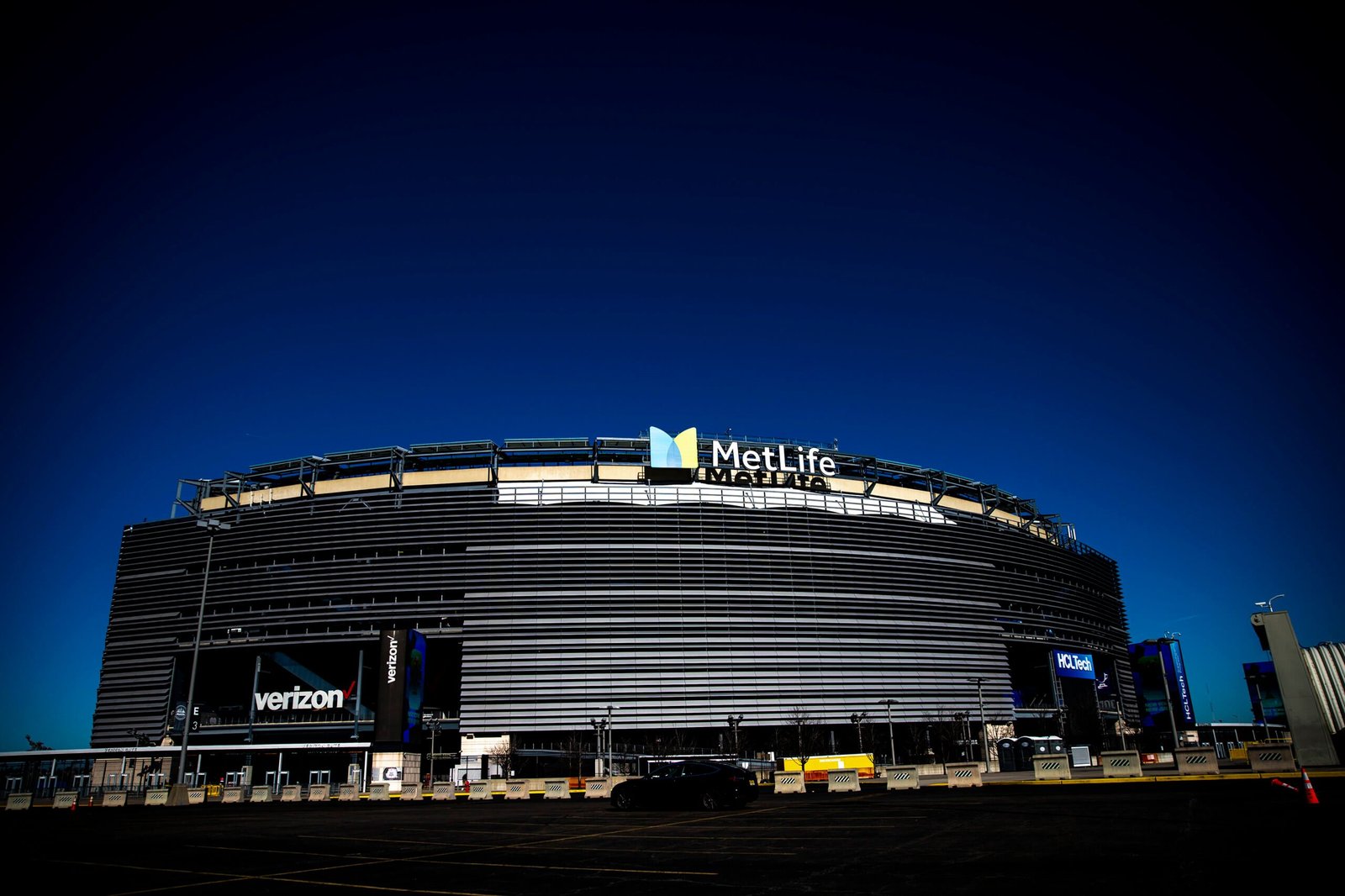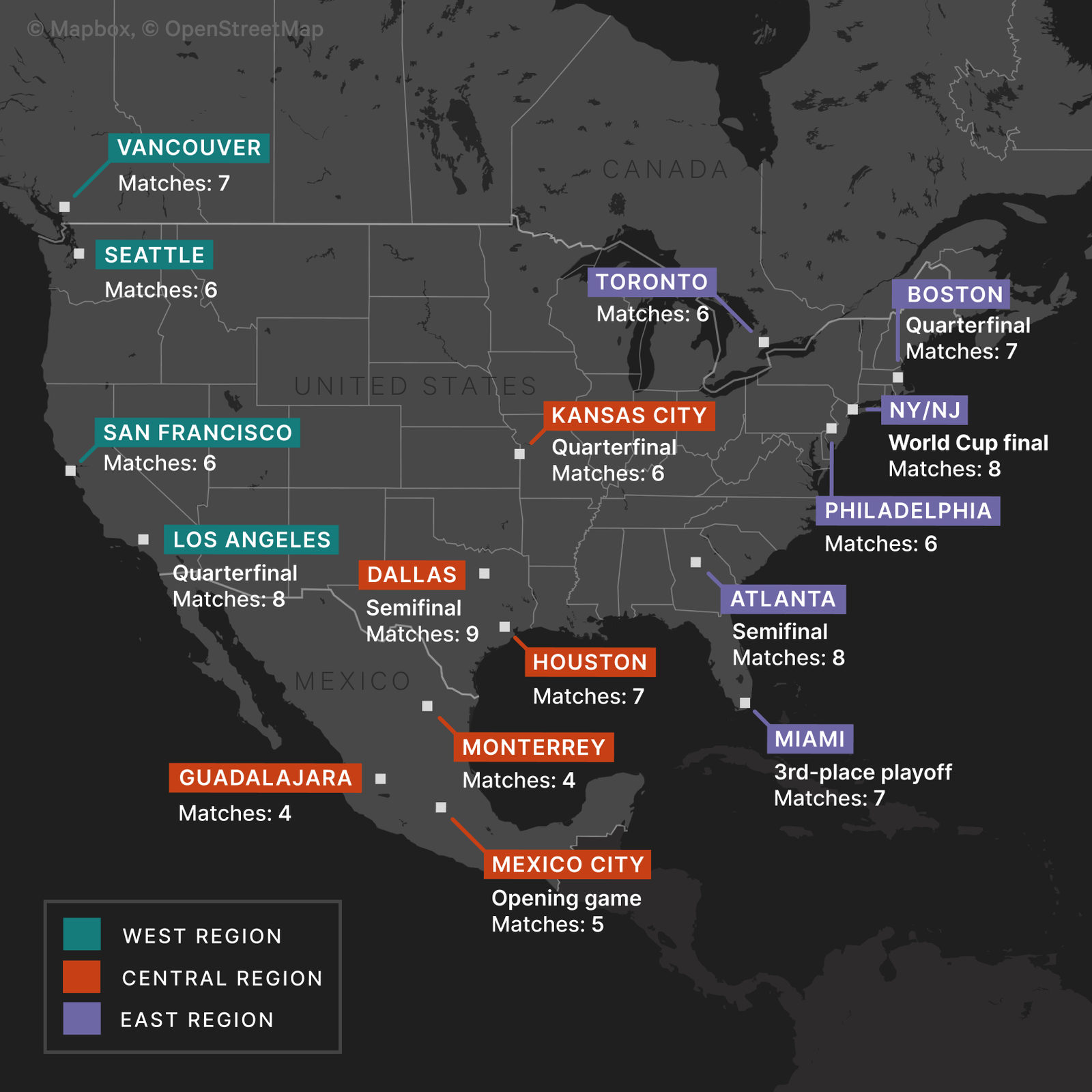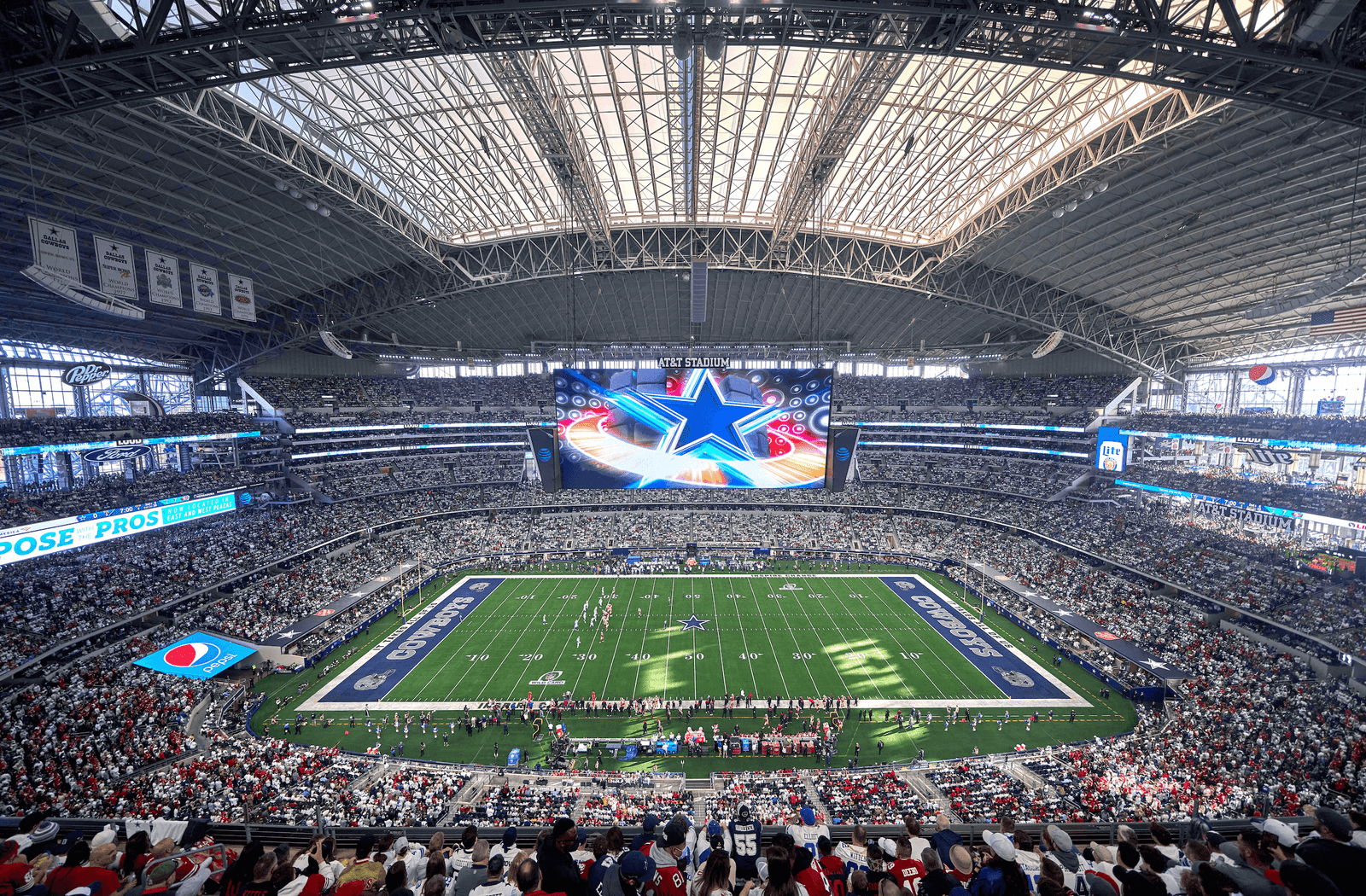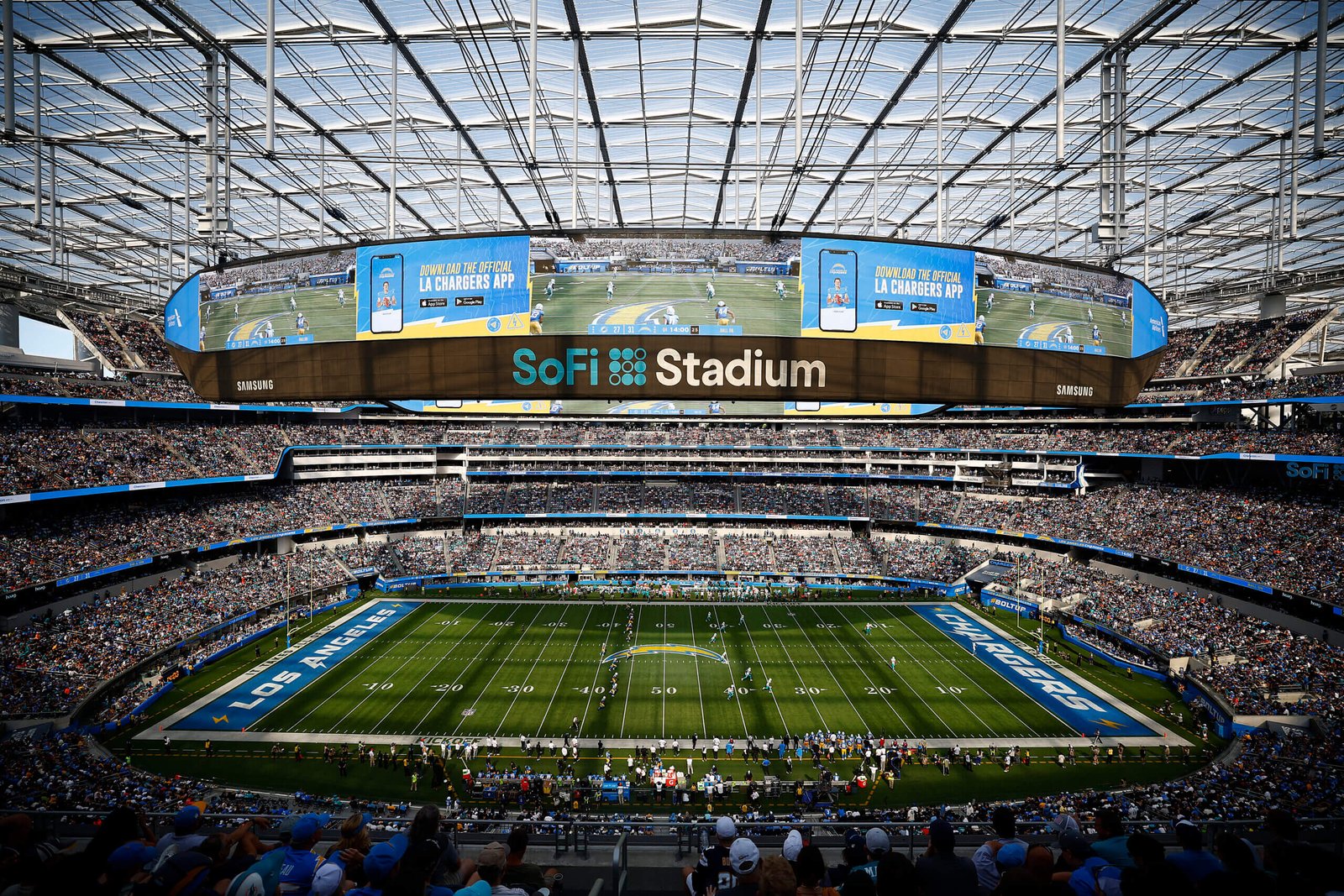Over the course of several days this fall, Gianni Infantino met with some of the most powerful leaders in sports, politics and global affairs.
He started with a public rendezvous at AT&T Stadium in Arlington, Texas, where he cozied up inside Jerry Jones’ luxury suite to catch his Dallas Cowboys take on the New York Jets. The face of the FIFA president, the man in charge of global soccer, was splashed across the venue’s jumbo screen. While in Arlington, Infantino met with more high-profile people, including Texas Gov. Greg Abbott and Jets owners Chris and Woody Johnson.
Days later, Infantino was again in front of the cameras. This time, in New York City, where he was all smiles next to New Jersey Gov. Phil Murphy and city mayor Eric Adams.
Infantino also took in at least two more NFL games: the New England Patriots versus the New York Jets at MetLife Stadium on Sept. 24, and the Miami Dolphins versus the Patriots on Oct. 29. The Patriots play at Gillette Stadium, which will host eight matches in 2026, and are run by Robert Kraft, an ally of the FIFA chief.
It was certainly a busy trip: Infantino also met with leaders in New York from the World Health Organization and United Nations, and the commissioners of the National Football League, National Hockey League and Major League Baseball. It can be little coincidence all those leagues have their headquarters in New York; a reminder of the staying power of a city that can feel at the center of the world.
On Sunday, Infantino was back on our screens, dressed in a beige hooded tracksuit in a Miami studio sitting next to Kevin Hart and Jenny Taft to be professionally excited about the “biggest World Cup ever”.
Infantino (left) and Hart (Brennan Asplen – FIFA/FIFA via Getty Images)
Kim Kardashian and son Saint got involved from Los Angeles, with Saint saying his favorite player was the U.S. national team midfielder Weston McKennie, while wearing a Real Madrid kit. It may not have been a U.S. jersey but it was at least was a shirt manufactured by Adidas, a FIFA sponsor, albeit sponsored by Fly Emirates — a direct rival to FIFA’s airline partner Qatar Airways.
Earlier in the day, Infantino had posted an Instagram collaboration with Kardashian to promote the launch event. She is part of an ambassadors’ program for the tournament and this was not a one-off appearance, with more celebrities and former players lined up to play similar roles.
We learned the FIFA president’s favorite Mexican food is tacos and then finally what we really needed to know: where the 104 matches of the 2026 World Cup will be played and, crucially, that the final will be at MetLife Stadium in New Jersey.
The 16 host cities across the United States, Canada and Mexico claimed to have little or no inkling as to which, or how many, matches they would be given. As late as Sunday morning, many key decision-makers were still professing ignorance. Only a very small circle of FIFA’s most senior executives — including Heimo Schirgi, now permanent COO of the World Cup 2026 after the departure of Colin Smith, and Matthias Grafstom, FIFA’s interim secretary general — made the final calls, with Infantino at the absolute forefront of the decision-making process.
This was not a Machiavellian plot to drive more viewers towards FIFA+, the organization’s streaming service, to watch the live announcement; more a reflection that the big choices were made very, very late.
This has been a theme of planning so far: after FIFA devoted so much energy to delivering the 2022 World Cup in Qatar, the 2026 edition is now coming up quickly. Mexico will open the tournament in Mexico City on June 11, 2026 — just 856 days’ time.
The schedule release was first expected in September, before being pushed back to the end of the year, and then to 2024. News of the location of the opening matches for the 2030 World Cup even came before we learned those plans for two years’ time.
The 2026 tournament will be the first World Cup without a national organizing committee, which means FIFA is tasked with pulling all the strings together. It’s also going to be the largest tournament in history with 48 teams and the competition is spread across three countries. This poses a significant organizational challenge.
For the 2022 edition in Qatar, FIFA became accustomed to asking a small clique of state-backed executives to make things happen and cover the costs, and invariably the answer was yes. This time around, FIFA — with its headquarters in Switzerland and a Miami base in the United States — has been attempting to negotiate with some of the richest men in U.S. sports. Dallas Cowboys owner Jones has a net worth of $12.8 billion, according to Forbes, and Kraft $11.1 billion. As well as high-profile stadium owners, there are city officials, local mayors, governors and private investors to contend with — never mind the various soccer governing bodies and leagues with vested interests, too.
For several months, the race to host the final appeared to have come down to Dallas and New York City — or rather the stadiums near to those cities: AT&T in Arlington, Texas, and MetLife in East Rutherford, New Jersey.

(Eduardo MunozAlvarez/VIEW press via Getty Images)
When Infantino said Dallas would host nine matches, the most of any 2026 host city, the realization that New Jersey may get the final began to sink in.
“I started a war game in my mind that that probably meant that they weren’t going to get the final,” Murphy told The Athletic on Sunday, moments after learning FIFA’s decision, “and I felt at that point that it was, more likely than not, that it would be us.”
“It was a hell of a battle,” a disappointed Jones said from Arlington. “We almost got there.”
That the New York/New Jersey bid was billed as a “surprise” choice by some close to the decision reflects just how close many felt Dallas came to landing global soccer’s showpiece event. When it comes to the dizzying world of FIFA politics, what seems an obvious choice may not always be the one made.
New York City appeared to be the logical choice for a World Cup final from the start, with its massive public transportation system (though one needing improved links to MetLife stadium), a less controversial political climate than Texas and a rich media market in a desirable time zone. The opportunities for commercial activations around some of the most recognizable landmarks in the world had executives salivating.
MetLife also successfully hosted the Copa America Centenario final in 2016, when Argentina fell to Chile for the second year in a row.
Murphy and Adams have long said their bid was the obvious choice. They published an op-ed arguing as much in November, after previously commissioning a poll with YouGov in the summer, which declared that soccer fans within the U.S. wished to attend a match in the New Jersey/New York region above any other. It was part of an increasingly intense lobbying campaign and within FIFA itself, plenty of the organisation’s commercial staff saw New Jersey as a no-brainer.
“We’re a soccer hotbed. We are as diverse as any region, not just in the country, but in the world,” Murphy said on Sunday. “And that is just so consistent with FIFA’s values.”
Yet the region was forced into an underdog role as momentum appeared to grow behind Dallas. Stories emanating from FIFA meetings in London in January appeared to tip the balance in Texas’ favor.
Craig Davis, the president and CEO of VisitDallas, the city’s visitors bureau, said on Sunday: “We’ve heard gossip from those involved in the bid that the British media first published the Dallas news because FIFA leaked it in an effort to get New York City to up their bid. Not saying that’s true. Just saying there were rumors.”
Were we really going to have a World Cup final under the bright lights of AT&T Stadium’s retractable roof? Had Jones managed to persuade Infantino of the major ticketing and hospitality benefits at the Dallas Cowboys’ stadium? Was the potential reception for U.S. presidential candidate Donald Trump if he chose to attend a final in New Jersey a factor?
‘Everything is bigger in Texas’ and that was the basis of Dallas’ bid. Jones said his team “represent, in the center of the country, what America’s about and our way”, adding: “We believe we showed the future.”
There were plans to sell as many as 200,000 tickets for a World Cup final — not just in the AT&T but at Globe Life Field, home of MLB’s Texas Rangers, and its previous home, Choctaw Stadium. There would have been simulcasts, concerts and fan parks to maximize the scale of the event.
The Dallas team was quick to trumpet the significance of having more matches than anyone else, with Jones heralding it “a fabulous success”, but suggestions this was a make-good deal to compensate for missing out on the final have been refuted. Instead, it is argued, Dallas’ excellent facilities and location in the Central Hub of cities (as shown below) counted in its favor in terms of cutting down players’ travel time.

(Graphic: John Bradford/Drew Jordan for The Athletic)
“This is a triumph,” added Jones. “This is a huge, huge success for every entity concerned here. While it’s easy to sit here and say you came in second, the real world is, seconds here are magnificent and that’s not an exaggeration.”
The lower key mentality of New Jersey/New York, however, may have been the key to its success. Through the winter, New Jersey and New York organizers have chosen to keep their public comments to a minimum. Meanwhile, in Dallas, officials were more willing to talk openly and candidly about their World Cup hopes.
Ahead of Sunday’s announcement, Dallas invited the press to AT&T Stadium, where celebrity athletes and local officials were on hand to answer reporters’ questions at the conclusion of FIFA’s broadcast. In New Jersey, organizers opted to meet for a private, press-free gathering of about 500 stakeholders at MetLife Stadium to tune into the announcement.
“We kept our head down. We didn’t get sucked into the rumor mill,” said Murphy. “We just sort of focused on our work, kept, as they say, our eyes on the prize, sort of shut the noise out, and it turned out that was probably a winning formula.”
Murphy on Sunday said he did not know FIFA’s decision for the final until Infantino shared it with the world. He described feeling “just elated” at the news.
“I knew we had a very good shot, but you just never know until the words come out of Gianni’s mouth,” Murphy said, acknowledging that “Dallas was the main competitor.”
Monica Paul, executive director of the Dallas Sports Commission, also said she found out with the rest of the world. “We did not get a heads up in terms of how many matches or if we’re getting a final,” she told reporters.

AT&T Stadium in January 2022 (Robin Alam/Icon Sportswire via Getty Images)
According to Dan Hunt, chairman of Dallas’ World Cup bid and FC Dallas president, “FIFA was very guarded. … They ran a very quiet process.”
FIFA spoke with organizers on a joint host city call before the announcement, assuring there would be no advance review or preview of their decision.
“I think the priority was to ensure that it would be a true reveal, and it was,” said Meg Kane, host city executive for Philadelphia 2026. “So, we learned it with the rest of the world.”
In late September, a FIFA delegation kicked off an operational tour in Miami which spanned several weeks and took in the 16 host cities. The delegation quietly concluded its tour in Vancouver in November, with little fanfare. Behind the scenes, however, it has been anything but quiet.
In December 2022 in Qatar, FIFA announced it expects to earn $11 billion in the 2026 World Cup cycle. The increased broadcasting, sponsorship, ticketing and hospitality revenues from a 48-team men’s tournament in North America would back up FIFA’s “unprecedented investment in football”, according to Infantino.
Among many city officials and billionaire owners in the United States, eyebrows were raised. Where was their slice of the pie?
Matters came to a head in Los Angeles by September of 2023. The Athletic reported SoFi Stadium owners Kroenke Sports & Entertainment (KSE) were dissatisfied with the terms of the deal to host World Cup fixtures.
The Kroenke family — which own English Premier League club Arsenal, as well as the LA Rams in the NFL, the Denver Nuggets in the NBA, the Colorado Rapids in MLS and Colorado Avalanche in the NHL — were not happy about how revenue would be shared between FIFA, the cities and the stadiums, according to multiple sources close to discussions. The Los Angeles FIFA World Cup Host Committee described the conversations as “ongoing, collaborative” and said it had been “working closely with FIFA on many aspects of the event”.
Costing around $5 billion, SoFi Stadium is the most expensive stadium ever built. But its pitch is about 63 feet too narrow to host a World Cup match and construction work is needed to introduce some retractable seating to adapt the playing field to size. Its capacity, according to the official bid book, is 70,240 — significantly less than AT&T Stadium (92,967) and MetLife Stadium (87,157), but LA organizers have worked on plans to try and hit closer to 80,000.

(Ronald Martinez/Getty Images)
Los Angeles had once been considered a direct rival to New Jersey for the World Cup final, with FIFA officials struggling to resist the lure of the global recognition and awareness of L.A. and New York. L.A. officials, meanwhile, made no secret that they viewed the two showpiece events of the tournament as the first match in the United States and the final.
Some at FIFA were under the impression that there may be more revenue to be had through the higher attendances in New Jersey or Dallas, but LA officials always insisted they were both competitive and available to host the final if selected to do so. The timezone also counted against LA’s chances, with major European broadcasting contracts also a factor.
Los Angeles has secured eight matches — five group-stage matches, two in the round of 32 and one quarterfinal. Significantly, the city was appeased by being awarded the first and third U.S. men’s national team matches in the group stage, as well as the right to host the first match in the U.S. during the tournament. This will enable L.A. to run a series of lucrative events in the days before the World Cup begins, with aspirations of major stars turning out to perform in a concert. In an ideal world, LA organizers would like performers to be genuine soccer fans as well as household names, while a series of fan activation events will also be arranged.
In New Jersey, millions of dollars have already been set aside to get MetLife and the surrounding area ready for World Cup games. These costs are often covered by taxpayer dollars, as in 2022 when it was widely reported New Jersey allocated $15 million in federal COVID-19 relief aid to sweeten its bid with FIFA.
With plenty more work still needing to be done, including a proposed transit plan costing $35 million, it’s fair to wonder who will be on the hook to cover the outlay. Will New Jersey and New York split the costs? “Yes, without question,” Murphy said during a five-minute appearance on FOX with Adams on Monday morning. He stressed the goal is that costs will largely be financed privately.
“We’re gonna raise an enormous amount of money — Eric and I, and our teams — from private sources,” Murphy said, “which is the way it should be.”
There is still plenty to be decided by FIFA in the coming months.
Expect Dallas to feature once again — they are still making a play to host the tournament’s referee headquarters or the International Broadcast Center, and are vying to be the base for one or two national teams in 2026, the chairman of Dallas’ World Cup bid told The Athletic in January. “There’s a whole litany of places,” Hunt said. “This is such a great market for soccer.”
Federations are still qualifying for the tournament, and team bases will be decided in the months or years to come. Kickoff times for games are also still being debated.
What’s certain, though, is city organizers can now finally sprint towards their next phase of planning for a World Cup final in New Jersey.
(Top photos: Getty Images; design: John Bradford)
Read the full article here


